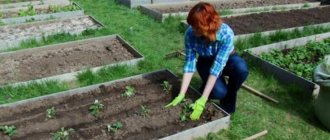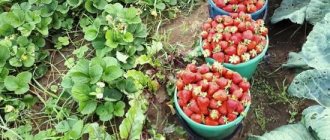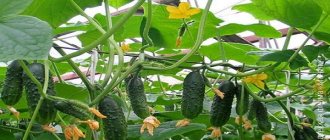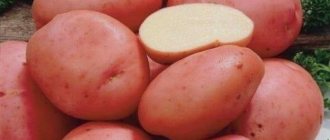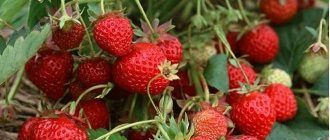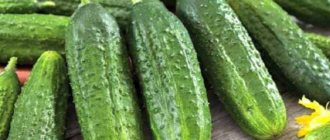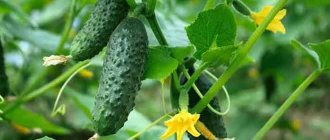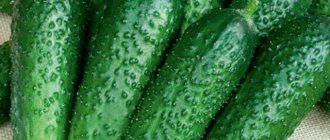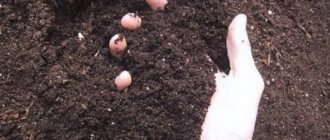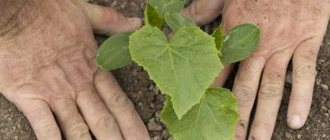Pandora (aka Malling Pandora) is a British garden strawberry that was bred by scientists at East Malling Research Station in 1988-1989. To obtain these garden strawberries, we had to cross the following varieties (Von Humbold * Redstar) * Merton Dawn.
And in today’s publication we will tell you in detail about this garden strawberry. In the article you will find its description, photos of its fruits and reviews from those gardeners who grew Pandora strawberries on their site.
Characteristics of Pandora's Malling
The plant is quite tall and abundantly covered with leaves. It is very easy to propagate Pandora, since the bush forms a fairly large number of strong mustaches.
The leaf blades are small in size and bright green in color. Glossy type, shines very well in the sun.
Molling Pandora blooms profusely; the bush forms up to 10 thin peduncles, which cannot hold the berries and lie on the ground.
The berries are quite large, round-conical in shape. At the first picking, the berries have the largest mass, up to 50-60 grams. With subsequent harvests, the weight of the berry drops to 25-30 grams.
The color of the shell of the Pandora fruit at the stage of technical maturity is orange-red. The berries are glossy and sparkle in the sun. At the stage of full ripening, the fruits acquire a dark cherry color.
Pandora fruits have an excellent taste. They are sweet and sour. The harmony between sourness and sweetness is maintained to the maximum.
The pulp of garden strawberries is medium dense, juicy, and the same color as a technically ripe berry. Exudes a pleasant strawberry scent.
The surface of the berry is dotted with small achenes of a yellow-red hue. The berries are planted quite deeply.
As noted earlier, the density of the berry is average, so it cannot be said that it can be stored and transported for a long time. Transportability indicators are within 3.5 points out of 5 possible. Therefore, when growing for commercial purposes, you need to pay attention to local markets or processing, since Pandora will not survive long-term transportation.
Despite the fact that it is a garden strawberry, its pollen is sterile. This is a huge disadvantage, which is why the variety is in such little demand in commercial circles. Pollen sterility indicates that the variety is self-sterile, that is, without a pollinator it will not be possible to obtain a good harvest.
Pandora berries begin to ripen towards the end of June. As for productivity, it is at a fairly high level. From 1 bush you can safely get up to 0.8 kg of berries.
Description of the variety
- Strawberry Pandora is a late variety. The plant begins to bear fruit at the moment when other species have finished doing so.
- It has increased frost resistance.
- But also during the cultivation period, Pandora Strawberries do not need to be covered for the winter.
Additional flower pollination can be challenging!
Due to the fact that flowering occurs quite late, the fruit bearings are not affected by spring frosts. Pandora strawberries have high immunity to most diseases of the root system.
About half a liter of berries is collected from a strawberry bush.
Characteristics of berries
- The berries are quite large.
- The average weight of Pandora's Strawberries is 60 grams.
- The fruits have a round shape.
- Initially, the berries become pink, but during the period of final ripening they acquire a dark red, sometimes burgundy hue.
- Strawberries become juicy and tasty.
- The aroma of the berries is reminiscent of wild strawberries.
Strawberry fruits are round in shape.
Vitamins and minerals
Pandora strawberries contain a huge amount of vitamins.
| Vitamins | Characteristic | Contents per 100 g. (mg.) |
| WITH | Refers to the strongest antioxidant. In case of infectious diseases, it activates the immune system. | 60 |
| A | Able to supply skin and cells with oxygen. Improves the condition of hair, nails and skin. | 0,005 |
| IN 1 | Supports the functioning of the gastrointestinal tract, reduces the risks of heart disease. Improves brain function. | 0,03 |
| AT 2 | Improves vision, as well as the condition of the skin, hair and skin. | 0,05 |
| AT 5 | Participates in the process of breaking down fats and carbohydrates in the body. | 0,3 |
| AT 6 | Able to regulate the proper functioning of the heart. Has a beneficial effect on hair and skin. | 0,06 |
| AT 9 | Necessary for the creation and development of cells in the body. During pregnancy, this vitamin is necessary for the proper development of the fetus. | 0,02 |
| E | It has a positive effect on the reproductive function of both men and women. | 0,5 |
In addition, the fruits contain a large number of minerals and trace elements.
| Minerals | Characteristic | Contents per 100 g. (mg.) |
| Potassium | Improves heart function. Prevents the development of atherosclerotic plaques. | 161 |
| Sodium | Needed to improve the functioning of the body as a whole. The microelement improves blood composition. | 18 |
| Magnesium | Provides prevention against heart diseases, in particular arrhythmias. | 18 |
| Sulfur | Produces collagen synthesis. Improves skin color. | 12 |
| Calcium | Prevents the development of osteoporosis and other diseases associated with the human skeleton. | 40 |
| Iron | Takes direct part in the metabolic process in the body. Needed for normal functioning of the gastrointestinal tract. | 1,2 |
Strawberry leaves protect the fruit from sunlight.
Peduncles
The plant produces a large number of flower stalks annually, due to which the yield of Pandora Strawberry remains high. The peduncles are located below the foliage and are quite thin. Often after the fruits ripen, the flower stalks along with the berries lie on the ground.
After the berries ripen, the flower stalks lean against the ground.
Foliage
The leaves of Pandora's Strawberry are slightly wrinkled and have a light green color. Closer to cold weather, the foliage acquires a dark color, and later even brown.
The leaves are slightly wrinkled and light green in color.
Positive and negative qualities of Pandora strawberries
This variety has been cultivated by gardeners around the world for quite a long time. During this time, they managed to highlight the main advantages and disadvantages of this garden strawberry. First of all, let's talk about the advantages of this strawberry. The main advantages of Pandora include:
- Excellent taste of berries.
- High yields. From 1 bush you can get up to 800 grams of marketable berries.
- Fairly good immunity.
- High resistance to low temperatures.
However, Pandora also has disadvantages, and there are quite a lot of them. The main disadvantages of this garden strawberry include:
- The main disadvantage of this variety is its self-sterility. You can get a good harvest only if you plant a pollinator variety nearby that has the same flowering time as the Pandora strawberry.
- Despite good immunity, Pandora is quite vulnerable to diseases such as brown spot and gray rot.
- The variety is poorly transported and stored, which is why it is not in great demand among entrepreneurs.
Description of the variety
The Pandora variety was bred in the UK by local breeders by crossing the Fragaria and Ananassa varieties. It belongs to late-ripening varieties - peak fruiting occurs at the end of July, which is undoubtedly a great advantage.
“Pandora” is not a remontant variety, but, nevertheless, once you harvest it once, you will be pleasantly surprised by the size of the berries and their pleasant taste, which you can enjoy at the end of the strawberry season.
A distinctive feature of Pandora over other varieties of garden strawberries is the need for pollinators during its flowering period.
As a pollinator, you can plant strawberries “Malvina”, which are similar in terms of ripening, or strawberries “Maxim”, “Florence”, “Vikoda”.
Proper planting of garden strawberries
Planting Pandora is no more difficult than other varieties of garden strawberries. The main thing is to follow a number of simple rules and then no problems will arise. First of all, you need to select a site and prepare it carefully. Site preparation begins 2 months before the start of planting work.
Requirements for the site:
- First of all, it should be located in the sun, since Pandora garden strawberries do not grow in the shade. Also, it is not advisable to plant strawberry bushes near tall trees and shrub crops.
- The area should be well ventilated, but at the same time protected from northern winds.
- Groundwater should not reach the soil surface too quickly. If it is not possible to grow strawberries in another area, then you need to make good drainage.
When the site has been selected, its immediate preparation begins.
Preparatory work includes:
- Complete cleaning of the area from weeds.
- Digging up the area to a depth of 30 cm.
- Fertilizer application. Approximately 6-8 kg of humus is added per 1 m2.
When the site is prepared, you can begin planting strawberries. As for timing, strawberries can be planted both in spring and autumn. Autumn planting will allow you to get a harvest in the next season, but you should be wary of frostbite of the root system, which has not had time to get stronger before the onset of cold weather (a problem can arise when planting strawberries in cold regions of the country). Spring planting allows you to avoid problems with frostbite of seedlings, but at the same time it will not allow you to get a harvest this season.
When the site has been selected and prepared, they begin to prepare the seedlings. The seedlings must meet the following requirements:
- Have a healthy root system. Pandora spines should not have any growths, stains, cracks, etc.
- The bush itself should also not be damaged or have diseases.
- It is best to choose medium-sized seedlings.
When everything is prepared, you can proceed to the actual planting. The procedure looks like this:
- Holes about 15 cm deep are dug in the area. The holes are dug at a distance of 30-40 cm from each other. The row spacing is made about 60-70 cm wide. This will give the bushes a lot of space, simplify harvesting and care, and also reduce the risk of crop disease.
- Seedlings are lowered into dug holes. The root system is carefully straightened over the hole. In this case, the seedling must be lowered into the hole in a strictly vertical position.
- The seedling is sprinkled with soil and compacted.
- At the end of planting, the bushes need to be watered. Consumption per bush is about 1 liter of water.
- Experienced gardeners recommend mulching the soil after planting in order to prevent the growth of weeds and reduce the rate of evaporation of moisture from the soil.
Preparing for winter
After the cold snaps, but before the onset of stable frosts, all dried leaves on the strawberry bushes are cut off. The growing point and healthy leaves should remain intact. After pruning, the soil surface is mulched with a layer of peat, straw or sawdust. In regions with little snowy winters, it is recommended to additionally cover strawberries with two layers of non-woven covering material.
If there is insufficient precipitation in the autumn, before the onset of a steady cooling, water-recharging irrigation is carried out. Plants overwinter much better in moist soil. In case of a large number of diseases, preventive treatment with fungicides is additionally carried out before mulching. For example, you can use Bordeaux mixture.
Caring for garden strawberries
Caring for Pandora is no more difficult than any other variety of garden strawberry. During the growing season, Pandora needs to be watered and fertilized.
Water garden strawberries strictly at the root. Watering should be done either in the early morning or in the evening, when the sun stops its activity. Also, watering should be carried out only with settled warm water. You cannot collect water from a well and immediately water your garden strawberries. This is fraught with the development of fungal diseases.
It is advisable to water strawberries systematically, once a week. If the sun is too hot and there is a drought, then the number of waterings is increased to 2/3 per week.
In addition to watering, you need to pay attention to timely fertilizing. In general, during the entire growing season you need to feed strawberries only 3 times:
- Strawberries are fertilized for the first time immediately after winter sleep. The first fertilizing should contain nitrogenous substances that stimulate the growth of the green part of the crop. You can feed it either with natural fertilizers (chicken manure, etc.) or purchased in specialized stores.
- The strawberries are fertilized a second time after they have bloomed and begun to form fruits. In this case, you need to use phosphorus-potassium substances that will help the plant produce a normal crop.
- The last feeding is carried out so that the plant survives the winter painlessly. Fertilize garden strawberries with organic matter after harvesting.
Naturally, in addition to this, you need to ensure that weeds do not appear on the site. Also, after each watering, it is recommended to carefully loosen the soil at the base of the bushes. This will saturate the root system with oxygen.
History of creation
Molling Pandora was bred by breeders D. Simpson and M. Blanke in 1988-1989 as a result of crossing the varieties (Von Humboldt x Redstar) x Merton Dawn. The work was carried out as part of a program for breeding new varieties of strawberries at the East Malling Research Station. It is the largest fruit research institute, located near the village of East Malling in Kent, UK. This is a truly legendary station, which has become the author of numerous generally recognized “masterpieces” among berry crops. It has also released many interesting new products in recent years. She herself is worthy of a separate article, but more on that next time.
Pests and diseases
As noted earlier, the variety has fairly good immunity. However, this should not be neglected. If you do not care for strawberries, they may encounter a number of diseases and pests. Let's talk in more detail about the problems that may arise when growing this variety:
- Gray rot. This is a common disease and the most dangerous for the Pandora variety of garden strawberries. In the presence of gray rot, a gray fluffy coating appears on the berries. To combat gray rot, you must first remove infected berries.
- Spotting. Spots are easily recognized when white or brown spots appear on the surface of the leaves. This disease has a negative impact on the development of fetuses. The berries become smaller, the yield is significantly reduced. Also, it is worth noting a significant drop in the taste of the fruit. To combat this disease, use a soap solution or special fungicides.
- Spider mite. When infested by this parasite, black dots appear on the foliage. The parasite causes the foliage and flowers to dry out. To combat this parasite, special insecticides are used.
Disease Control
Most strawberry diseases occur due to non-compliance with agricultural practices. The most common of them are discussed in detail below.
Gray rot
Massive spread of gray rot is observed with the onset of warm and humid weather. Heavily dense plantations suffer especially from it. If left untreated, up to 90% of the crop can die. The main way gray mold spreads is through infected plant debris and fruits. Their regular collection is an excellent prevention.
Powdery mildew
A widespread fungal disease. Massive outbreaks of powdery mildew occur after rainy, cool weather. First, spots with a white coating resembling flour appear on the surface of the leaf plates. With further progression of the disease, necrosis develops in their place. As a result, the infected parts die.
Powdery mildew is very difficult to cure. The fight against it must be comprehensive. Plantations where outbreaks of powdery mildew were observed in the previous season are treated with copper-containing fungicides in early spring. Spraying is carried out twice with an interval of 10 days. The next treatment is carried out after flowering has ended. The last one is in preparation for winter. Spores of the powdery mildew fungus overwinter well in plant debris, so they must be destroyed in a timely manner.
Reviews from gardeners
Nikolai Vladimirovich, Minsk, 47 years old.
I'll tell you about the Pandora variety. I'll try to be brief. Ripens very late. And this is not a disadvantage, but a huge plus, since strawberries can be eaten after all the varieties have already “sung their song,” as they say. The variety is self-sterile, I planted a pollinator, but somehow in the first year Pandora did not form flower stalks well. The bushes are compact, there are many leaves. The peduncles are thin, located below the level of the leaves. The mustache forms well. The first harvest is quite large, the berries have a flattened shape. Then the berries become smaller, approximately 2 times smaller, and become more round. The taste is very good, pronounced.
Nadezhda Alexandrovna, Lvov, 41 years old.
I didn't like strawberries at all. The berries may be beautiful and large, but the taste is nothing. No strawberries. They thought that in the first year the harvest was nothing, but in the second year it was just as bad, so they abandoned it.
Methods of culture propagation
Pandora strawberries are usually propagated in two ways:
- With mustaches, or young shoots, is the simplest option. When side shoots appear, they are sprinkled with damp soil, and after rooting they are dug up, cutting off those tendrils that lead to the mother plant.
- By dividing the bushes - this is how adult specimens of Malling Pandora, well-leafed and with a large number of shoots, are propagated. After fruiting has ended, a suitable plant is dug up and divided into 2-3 parts so that each has a long root and at least three leaves. Plant the plants immediately.
The seed method for propagating Pandora strawberries is used extremely rarely. Not only because it is extremely time-consuming and labor-intensive, but mainly because in the Molling Pandora hybrid, propagation by seeds does not preserve the parental properties of the variety.
Strawberry Ostara
Although the Ostara strawberry is a foreign variety, it has taken root in my Moscow region. The bushes are not large. The berries in the 1st year were medium and small, the taste was pleasant, I was especially pleased with the strawberry aroma of strawberries. I like wild strawberries more than strawberries, but here it turns out like a large strawberry, although not as sweet. I liked the harvest of the 1st year, but in the 2nd year I received mostly small berries. This variety is remontant and berries can be found on it at different times of the warm season, so the bushes quickly degenerate and need to be renewed, which I don’t really like. For me, it’s better to plant bushes once and collect berries from them for several years, but this variety is not like that - it needs to be renewed almost every year. It is not necessary to buy new seedlings; this strawberry produces a lot of tendrils that can be used as seedlings, and the excess tendrils can be removed. Quite a hassle of care, but if you work with strawberries, you can pick them for a long time, even if they are not large ones. In addition to renewal and watering, strawberries need to be fertilized abundantly, covered for the winter, and if the summer is rainy, then the berries must be separated from the ground so that they are not affected by rot. The berry is delicate, can be easily deformed, it cannot be transported, but it is delicious to eat.
My experience in growing Ostara strawberries is only 2 years. Before that, I grew ordinary strawberry varieties with different ripening periods - early, middle and late. Then I decided to try to grow a remontant variety that bears fruit from late spring to late autumn and chose this variety as a sweet one. I planted the seedlings in the spring in a separate bed, the distance between the bushes is about 30 cm. Within a month, the seedlings not only grew, but also threw out flower stalks. I removed them to harvest the next year, and in the first summer I just wanted to grow seedlings. My bushes overwintered well, I simply covered them with straw, and despite the frosts and freezing rain, all the bushes bloomed in the spring and produced the first berries, quite large ones. The taste of the berries of remontant varieties is not as rich and sweet as compared to regular ones, but this variety retains its sweetness and rich aroma. These strawberries were harvested every month until October, and the autumn berry was sweet. But in the 2nd year the berries grew smaller, and I learned that I need to renew the bushes as often as possible or the berries will be small. While I’m eating this berry, the yield is falling, but next year I’ll have to develop new beds and grow new young plants.
I have conflicting impressions of Ostara strawberries. On the plus side, the variety is frost-resistant and well adapted to our climate. I have never had these strawberries affected by diseases. It's also not difficult to care for - regular watering, weeding, nothing complicated. The variety bears fruit until autumn and the berries are quite tasty, especially in autumn, when there are no berries from other varieties of strawberries for a long time. The downside is that the berries quickly become smaller. My bushes degenerated after 2 years. In principle, if you don’t chase the yield, then the bushes will produce berries, but they are small and there are not so many of them to make preparations. And the shape of the berries is ugly, irregular, and if you pick the berries, they don’t look appetizing on the plate. I grind this harvest with sugar, it turns out tasty and aromatic. This berry is also fragile, and when it is small, it is especially difficult to separate it from the stalk, which it firmly holds on to - the berry easily crushes in your hands. If the berry of this variety still reaches medium size, then it cannot be transported due to its fragility. And it doesn’t hold its shape well in the preparation, for example, when frozen or when making jam with whole berries. It is better to grind or cook compote from small berries.
I planted the Ostara variety to eat strawberries in the summer until September. Following all the recommendations for growing this variety, I strengthened and grew the bushes for one summer, and harvested berries for 2 years. It bears fruit for a long time, you need to constantly care for the garden bed and harvest regularly, but the harvest itself is small at one time and only for food, and there is not enough for harvesting. The taste of the berry seemed mediocre to me - when the berry is small or in rainy weather, it is sour or watery, and I eat such a berry without pleasure. At the peak of ripeness and in sunny weather, this berry is sweet and sour, like a vitamin - it is healthy, but also not particularly tasty. The berry lies on the ground, has a thin skin, so there is a risk of rot in rainy summers, and slugs love this berry, you need to set traps. After 3 years, the bushes need to be renewed so that the berries are not small. But it produces mustache constantly and well, you don’t need to buy new seedlings, you can grow your own. I leave 1 bed of these strawberries for variety, so that I can eat strawberries fresh from the bush until the fall, but I don’t want to grow them too much. There are varieties of larger strawberries, from which I make preparations, but this variety is too small.
Recommendations for cultivation
Pandora strawberries are planted on cultivated, well-fertilized, loose soils. Planting is done in early spring or late autumn. If the seedlings have buried roots, then they can be planted in the summer. The place for planting strawberries should be well-lit, dry, without drafts or cold winds. The soil is suitable with an admixture of sand and clay, with a neutral acidity level. On the eve of planting, the soil should be well fertilized with organic matter and minerals. Water strawberries in hot weather 2-3 times a week, and in cloudy weather - once a week. Watering is done early in the morning from a watering can. It is possible to use the drip irrigation method
It is important not to overwater or overdry the plantings. Since ripening strawberries literally lie on the ground, a layer of mulch in the form of straw or sawdust is laid under the bushes. This prevents the berries from rotting. The most effective fertilizing is ammonium nitrate, bird droppings or manure diluted with water.
Do not allow a solution of organic fertilizers to come into contact with strawberry leaves, as this may cause them to burn. Strawberry bushes must be weeded regularly, after which the soil in the root circle should be loosened shallowly. It is recommended to tear off excess leaves. This allows the bush to save nutrients, which are used for fruit development. Pandora strawberries can be grown in one place for 4 years, then replanting is necessary, otherwise the berries begin to shrink and degenerate.
